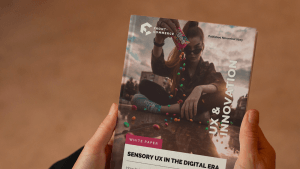How to incorporate sensory appeal in your UX design, & create an engaging and memorable user experience. Please fill out the form to access the White Paper .
What’s inside?
-
The rise of sensory UX
-
Why is sensory UX important?
-
Creating an immersive experience online.
-
Technical limitations
-
Creating UX for a products that require taste, smell or touch
-
Case study
-
The future of sensory experiences
-
Branding ready for the future
Creating an immersive, multi-sensory UX online
In the competitive landscape of retail, businesses strive to forge lasting connections with their customers. Sensory experiences offer a powerful avenue to cultivate these emotional bonds, deeply etching brand imprints into the minds of consumers.
While visual and auditory senses are readily catered to through high-quality images, engaging videos, and captivating background music, stimulating the senses of taste, touch, and smell presents a unique challenge. However, the rise of sensory UX design has opened up a world of possibilities, enabling brands to evoke vivid sensory experiences through evocative written descriptions and immersive visuals. These advancements underscore the transformative potential of sensorial design in shaping the future of digital experiences.
The advent of cutting-edge technologies further expands the possibilities of sensory design, extending beyond physical products to encompass digital environments. Haptic feedback, once exclusive to gaming consoles, now finds its way into smartphones, providing users with a sense of touch through vibrations. Scent diffusers, originally confined to aromatherapy sessions, are now being integrated into virtual reality experiences, allowing users to perceive the essence of virtual landscapes.
